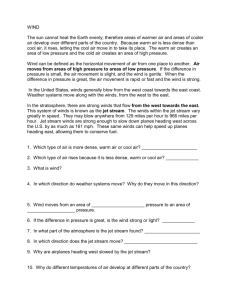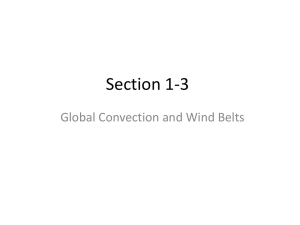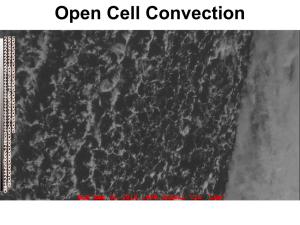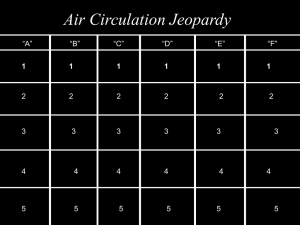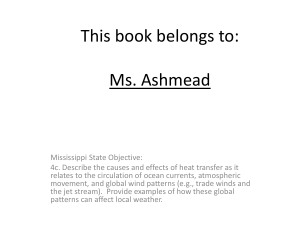6-4.9 - S2TEM Centers SC
advertisement
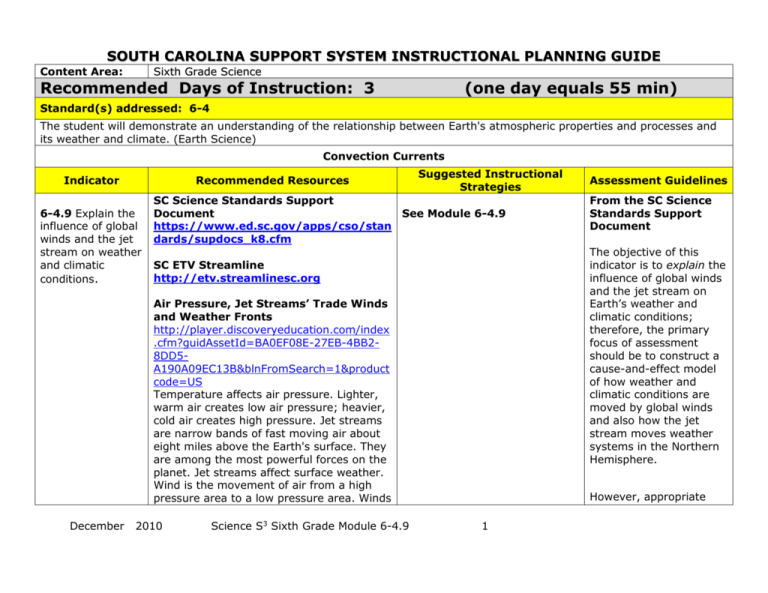
SOUTH CAROLINA SUPPORT SYSTEM INSTRUCTIONAL PLANNING GUIDE Content Area: Sixth Grade Science Recommended Days of Instruction: 3 (one day equals 55 min) Standard(s) addressed: 6-4 The student will demonstrate an understanding of the relationship between Earth's atmospheric properties and processes and its weather and climate. (Earth Science) Convection Currents Indicator Recommended Resources 6-4.9 Explain the influence of global winds and the jet stream on weather and climatic conditions. Suggested Instructional Strategies SC Science Standards Support Document See Module 6-4.9 https://www.ed.sc.gov/apps/cso/stan dards/supdocs_k8.cfm 2010 Science S3 Sixth Grade Module 6-4.9 From the SC Science Standards Support Document The objective of this indicator is to explain the influence of global winds and the jet stream on Earth’s weather and climatic conditions; therefore, the primary focus of assessment should be to construct a cause-and-effect model of how weather and climatic conditions are moved by global winds and also how the jet stream moves weather systems in the Northern Hemisphere. SC ETV Streamline http://etv.streamlinesc.org Air Pressure, Jet Streams’ Trade Winds and Weather Fronts http://player.discoveryeducation.com/index .cfm?guidAssetId=BA0EF08E-27EB-4BB28DD5A190A09EC13B&blnFromSearch=1&product code=US Temperature affects air pressure. Lighter, warm air creates low air pressure; heavier, cold air creates high pressure. Jet streams are narrow bands of fast moving air about eight miles above the Earth's surface. They are among the most powerful forces on the planet. Jet streams affect surface weather. Wind is the movement of air from a high pressure area to a low pressure area. Winds December Assessment Guidelines However, appropriate 1 curve because of Earth's rotation. In the temperate zone, warm and cold air clash along weather fronts. December 2010 Science S3 Sixth Grade Module 6-4.9 assessments should also require students to interpret diagrams related to global winds or the jet stream; compare the movement of weather systems between the global wind belts; identify the wind belts and their prevailing wind directions; or recall the curving of global winds as the Coriolis effect. 2 Sixth Grade Science Module 6-4.9 Global Winds and the Jet Stream Lesson A Standard 6-4: The student will demonstrate an understanding of the relationship between Earth's atmospheric properties and processes and its weather and climate. (Earth Science) Indicator 6-4.9: Explain the influence of global winds and the jet stream on weather and climatic conditions. December 2010 Science S3 Sixth Grade Module 6-4.9 3 From the South Carolina Science Support Documents: Indicator 6-4.9: Explain the influence of global winds and the jet stream on weather and climatic conditions. Taxonomy level of indicator: Understand Conceptual Knowledge: (2.7-B) It is essential for students to know that global winds are found in each convection region (6-4.8). Because convection cells are in place in the atmosphere and Earth is spinning on its axis, these global winds appear to curve. This is known as the Coriolis effect. In the global wind belt regions, the prevailing direction of the winds and how air movement in these large regions affects weather conditions. Global winds The trade winds blow from east to west in the tropical region moving warm tropical air in that climate zone. The prevailing westerly winds blow from west to east in the temperate region. The temperate zone temperatures are affected most by the changing seasons, but since the westerly wind belt is in that region, the weather systems during any season move from west to east. Since the United States is in the westerly wind belt, the weather systems move across the country from west to east. Tropical weather systems, for example hurricanes, are moved in the prevailing direction of the trade winds. If they enter the westerly wind belt, they are often turned, and move in the direction of that prevailing system. The polar winds blow northeast to west in the polar region moving cold polar air in that climate zone from the poles toward the west. Jet stream A fast-moving ribbon of air that moves from west to east in the Northern Hemisphere around Earth. It dips and bends and constantly changes positions. As these changes occur, air masses and weather systems in its path are moved along by the fast moving air. The polar jet stream can bring down cold polar conditions from the north. The subtropical jet stream can bring warm tropical conditions from the south (in the northern hemisphere). It is not essential for students to explain the cause of the jet stream or the global wind belts. The effects of latitude, topography, and elevation on climate patterns are not included in this indicator. Assessment Guidelines: The objective of this indicator is to explain the influence of global winds and the jet stream on Earth’s weather and climatic conditions; therefore, the primary focus of assessment should be to construct a cause-and-effect model of how weather and climatic conditions are moved by global winds and also how the jet stream moves weather systems in the Northern Hemisphere. However, appropriate assessments should also require students to interpret diagrams related to global winds or the jet December 2010 Science S3 Sixth Grade Module 6-4.9 4 stream; compare the movement of weather systems between the global wind belts; identify the wind belts and their prevailing wind directions; or recall the curving of global winds as the Coriolis Effect. December 2010 Science S3 Sixth Grade Module 6-4.9 5 Teaching Indicator 6-4.9: Lesson A-- “Global Winds” Instructional Considerations: This lesson is an example of how a teacher might address the intent of this indicator. Science and Technology Concepts for Middle SchoolTM (STCTM) Catastrophic Events and FOSS Weather and Water provide an opportunity for conceptual development of the concepts within this standard. In 6-4.8 students examined the development of convection currents and their effects on the Earth’s weather. This indicator expands on that idea by looking at the global wind belts and how their path is affected by the spinning of the Earth’s axis. It is the prevailing direction of the winds and how air moves in these large regions that affects weather patterns. This indicator contains new conceptual material. Students will expand on this knowledge in high school Earth Science as they then develop understanding of the Coriolis Effect and also look at the causes and evidence for global climate changes. Students will also study geographic influences attributed to global climate patterns. Preparation for this Lesson: Make sure you have copies of daily weather maps. The internet is a good source for these. Misconceptions: Students of all ages (including college students) may believe that air exerts force or pressure only when it is moving and only downwards. Only a few middle-school students use the idea of pressure differences between regions of the atmosphere to account for wind; instead they may account for winds in terms of visible moving objects or the movement of the earth. http://strandmaps.nsdl.org/?id=SMS-MAP-1698 Students often account for winds in terms of the movement of the Earth or the coldness of the poles. They often relate wind speed to temperature, linking a high speed with colds winds and assuming a warm wind to be gentle or slower. Making Sense of Secondary Science; Rosalind Driver, Squires et al. Safety notes: none noted Materials Needed Daily maps showing the jetstream Paper plates Markers Activity: Global Wind Belts and Convection Currents from Anderson School District 5 Curriculum (6th Grade) Focus Question: How do global winds and the jet stream affect weather conditions? Engage: 1. Show students a weather map of the US (refer them back to one you used in Lesson A of indicator 6-4.4.) December 2010 Science S3 Sixth Grade Module 6-4.9 6 2. 3. 4. 5. Ask them to pinpoint the location of the weather SC can expect in the next couple of days. Have them give a reason for their answer. Ask students to write anything they know about the jet stream in their notebooks. Tell them that you are going to explore further how the movement of wind belts affects our weather in SC as well as how the Coriolis Effect affects the Global Wind Belts. Explore: 1. Provide students with materials and instructions for investigating the Coriolis Effect. 2. Pairs of students need: a white paper plate and a marker a. Have one student place the marker in the center of the plate. b. Ask the second student to spin the plate clockwise while the first student tries to draw a straight line from the center to the outside edge of the plate. c. Students label this line A. d. Repeat as the other student tries to draw a straight line while his/her partner spins the plate counterclockwise. Label this line B. 3. Ask students to talk about what they observed. Could they draw a straight line? Why? Why not? What was the shape of the line? Why? (Line curves to left when plate is turned counterclockwise and right when spun clockwise) 4. Have students complete Global Wind Belts and Convection Currents Activity from Anderson School District 5 Curriculum. Explain: 1. Ask students to explain what they observed and why they think that was true. 2. Ask students what the spinning of the plate clockwise and counterclockwise represents? (Earth spinning on it’s axis) 3. Students have already investigated how differences in air pressure and uneven heating of the earth produce movement of air called wind. 4. Tell them that because of the curved surface of the Earth and the Earth’s rotation, winds curve westward in the northern hemisphere and eastward in the southern hemisphere. 5. For this reason, weather in the US generally moves west to east in the wind belt called the prevailing westerlies…..called that because the global winds move from west to east in the wind belt in which we live. 6. Ask students to compare their work with the Activity: Global Wind Belts and Convection Currents to their learning from earlier lessons. 7. Ask students to share what they might know about the jet stream. Provide them with examples of when they might have heard this term. Pilots will sometimes talk about the difference in flying time with the jet stream and against the jet stream. During seasonal weather reports, meteorologists often point out the jet stream as the reason for cooler or warmer temperatures than normally expected. 8. Describe the jet stream using a diagram or picture and sharing the following information. December 2010 Science S3 Sixth Grade Module 6-4.9 7 9. The Jet stream is a fast-moving band of air that moves from west to east in the northern hemisphere. Wind speeds may reach 500 kph (310 mph). It constantly changes positions. Air masses and weather systems are moved by the fast moving air. The polar jet stream, like the one in this diagram, brings down polar conditions from the north. The subtropical jet stream can bring warm tropical conditions. 10. Suggested Streamline Video: 11. 12. Air Pressure, Jet Streams, Trade Winds and Weather Fronts (See Resources) Allow time for students to return to their notebook entries on the wind belts and jet stream. Ask them to draw a “line of learning” (a line separating their original thoughts from new learnings) and add any new learnings below the line. Provide time for students to share with a partner then engage all in a whole class share. December 2010 Science S3 Sixth Grade Module 6-4.9 8 Extend: 1. Find the current path of the jet stream each day at this site: http://www.weather.com/maps/activity/aviation/mondayusjetstreamforecast _large.htm 2. Have students research the names for the global wind belts and share their origins. December 2010 Science S3 Sixth Grade Module 6-4.9 9 Global Wind Belts and Convection Currents Directions: 1. Color the blank Earth (4). Color the water blue and the land green. 2. Color the global and wind belts (3). Polar easterlies – blue, westerlies – green, trade winds – red. 3. Color the convection current zones (2). Color polar – blue, temperate – green, tropical – red. 4. Color the surface currents (1). Color the Gulf Stream Current – red, the California Current – top blue and bottom red. 5. Cut out each picture (cut around the tab and around the convection currents on #2. 6. Glue the tab to your paper or construction paper in this order – 1 on bottom, then 2, 3, and 4 on top. 7. Fold a piece of paper into 4 sections. 8. Label the first section, Global Wind Belts. Write a brief description and color code the names to match your global wind belt globe. Write a small number 3 in the corner of this section. 9. Label the second section, Convection Currents. Write a brief description and color code the names for each zone to match your convection current globe. Write a small 2 in the corner of this section. 10. Label the third section, Surface Currents. Write a brief description and key for currents A and B. Write a small1 in this section. 11. Use the last section for your title, Global Wind Belts and Convection Currents. 12. Cut out each section. 13. Put glue along the left side of the sections and glue them below your globes in this order – 1 on bottom, then 2, 3, and 4 on top. December 2010 Science S3 Sixth Grade Module 6-4.9 10 Global Wind Belts Convection Belts winds that blow over a large areas where large area of Earth warm air rises and cold air replaces it. Polar Easterlies Polar Westerlies Temperate Trade Winds Tropical 3 2 Surface Currents when warm water rises and is replaced by cold water Global Wind Belts and Convection Currents A. Gulf Stream Current B. California Current 1 December 4 2010 Science S3 Sixth Grade Module 6-4.9 11 1 2 4 3 December 2010 Science S3 Sixth Grade Module 6-4.9 12 Global Wind Belts and Convection Currents Model Rubric Name: Period: Date: Criteria Possible Points Coloring is neat and accurate Earth Global Wind Belts Convection Current Zones Surface Currents 40 (10 per section) Accurate Descriptions Earth Global Wind Belts Convection Current Zones Surface Currents 40 (10 per section) Assembled Correctly 20 Total 100 December 2010 Science S3 Sixth Grade Module 6-4.9 Earned Points 13 December 2010 Science S3 Sixth Grade Module 6-4.9 14

